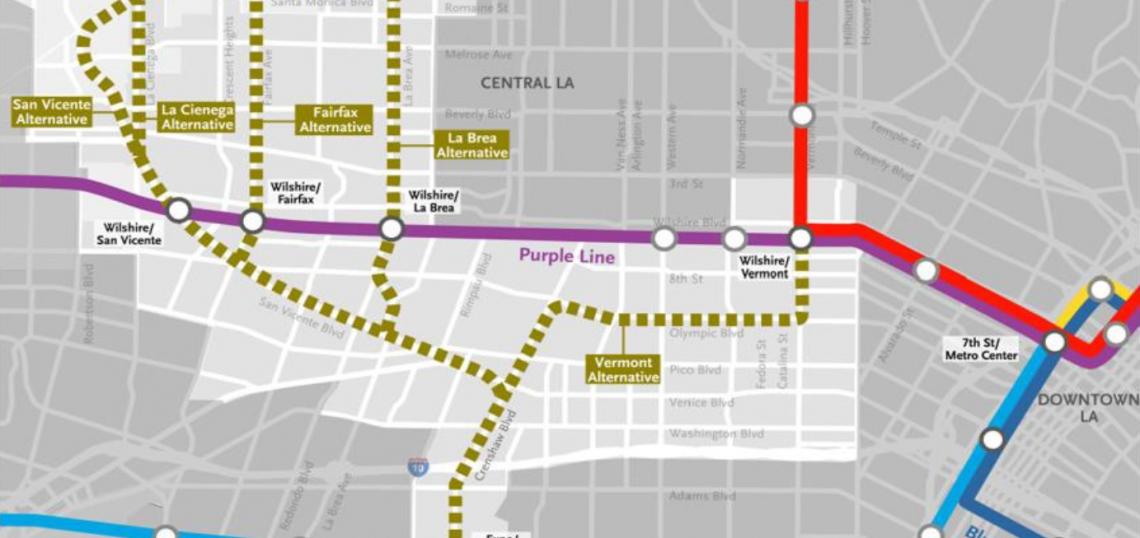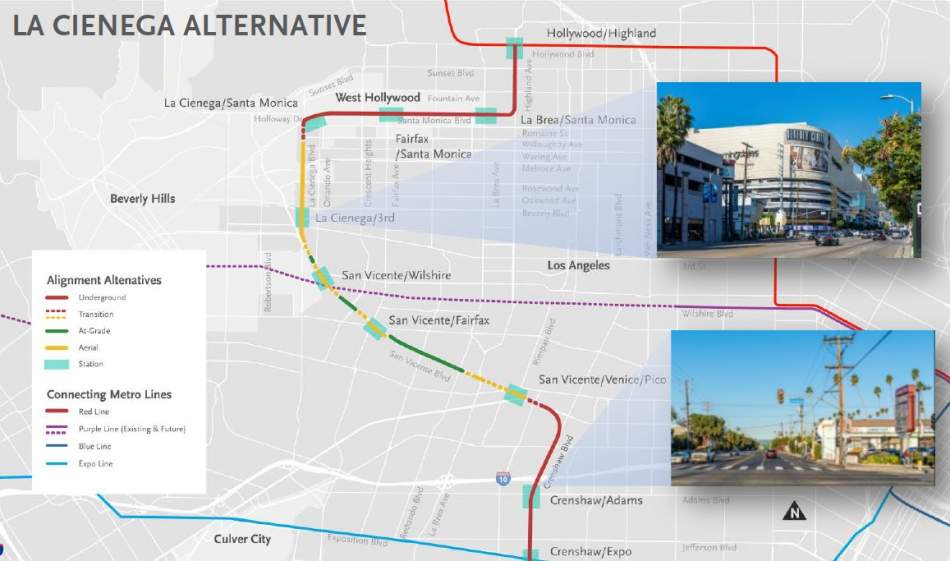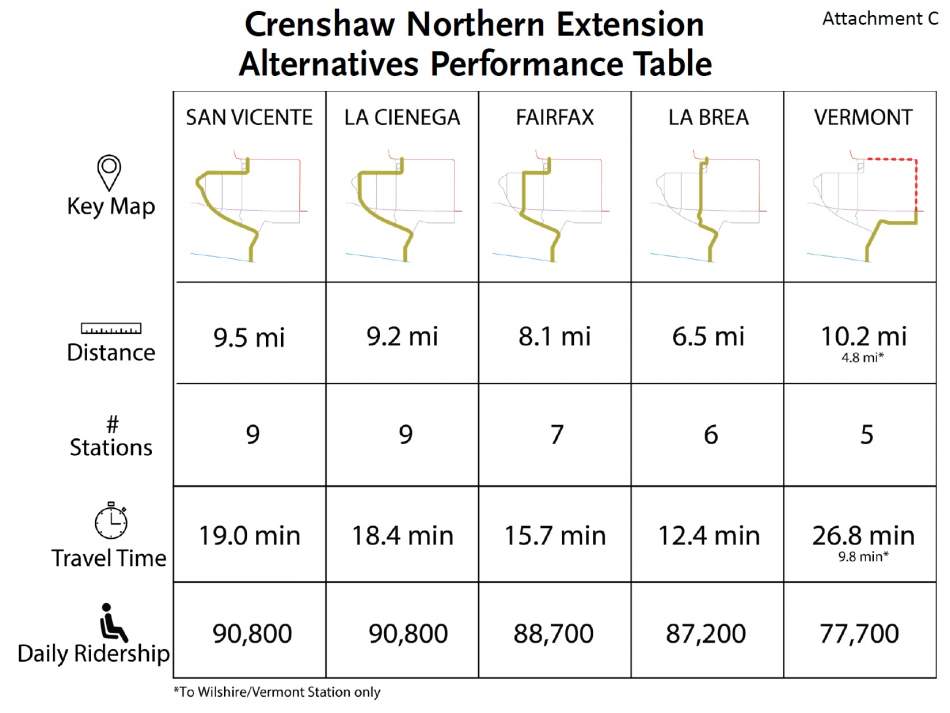At its meeting on July 26, Metro's Board of Directors is scheduled to receive a presentation on potential alignments for the planned northern extension of the Crenshaw/LAX Line - a $2.2-billion project that is being funded in part through half-cent sales tax levied via Measure M. Under current plans, construction is set to begin in 2041 and conclude by 2047 unless means to accelerate the project are found.
The report, prepared by engineering and construction giant AECOM, offers five possible routes to connect the current underground terminus with the Mid-Wilshire district and Hollywood. It examines an approximately 17-square-mile area that is home to more than 330,000 residents and roughly 184,000 jobs.
The five alternatives include:
San Vicente
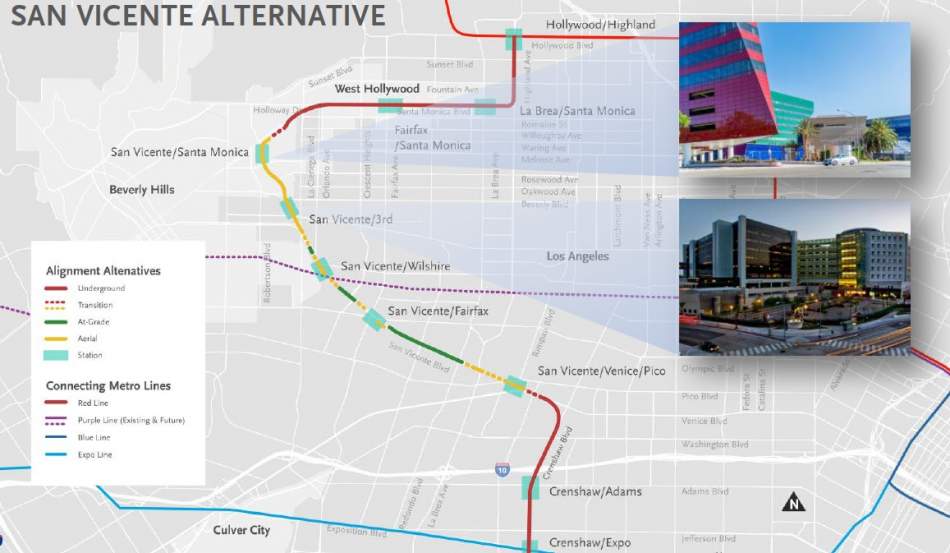
The San Vincente alternative - like each of those that will follow - begins with at the subway stop currently under construction beneath the existing Expo/Crenshaw Station. From there, operations would continue as a subway under Crenshaw Boulevard - with one stop at Adams Boulevard - before veering west onto an aerial guideway at Venice Boulevard, with an additional station at the Midtown Crossing shopping center, which the study identifies as a candidate for a mixed-use redevelopment.
From there, trains would transition to San Vicente Boulevard, where operations would occur at-grade along its wide center median - a historic streetcar right-of-way. Aerial stations are planned at major intersections such as Fairfax Avenue and Wilshire Boulevard. The study indicates that at-grade operations could be packaged with a "complete streets" reconfiguration of the adjoining section of San Vicente.
North of Wilshire, the San Vicente alternative calls for aerial structures - with stations at 3rd Street (adjacent to the Beverly Center and Cedars-Sinai's main campus) and Santa Monica Boulevard (adjacent to the Pacific Design Center). The San Vincente/Santa Monica station could potentially provide an opportunity for a redevelopment of the nearby Division 7 bus depot, which is Metro-owned property.
At this point, the alignment turns east to subway tunnels beneath Santa Monica Boulevard to serve the City of West Hollywood, and eventually veering north again below Highland Avenue towards a terminus at Hollywood & Highland. Stations along this segment would be located at Fairfax Avenue, La Brea Avenue, and Hollywood & Highland.
La Cienega
The La Cienega alternative serves a similar range of destinations to its San Vicente counterpart. However, instead of continuing north along San Vicente past 4th Street, the proposed aerial structure would travel along La Cienega. However, this option does not offer the same redevelopment opportunities for the Division 7 bus maintenance facility.
Fairfax
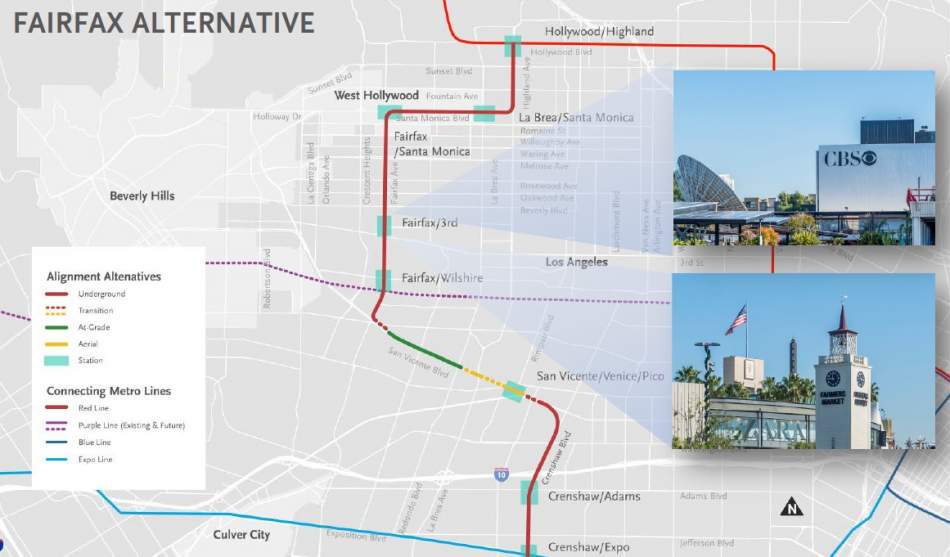
Under the Fairfax alternative, the at-grade tracks along San Vicente Boulevard would transition to fully subterranean operations at Fairfax Avenue, where trains would turn north to serve Beverly Grove and Fairfax Village.
Stations would be located at Wilshire Boulevard and 3rd Street, which would serve a range of destinations including LACMA, Park La Brea, The Grove, the Farmer's Market, and CBS Television City.
This alignment also turns east at Santa Monica Boulevard in West Hollywood, with potential stations at Fairfax and La Brea Avenues. It would also terminate at the Hollywood & Highland complex.
La Brea
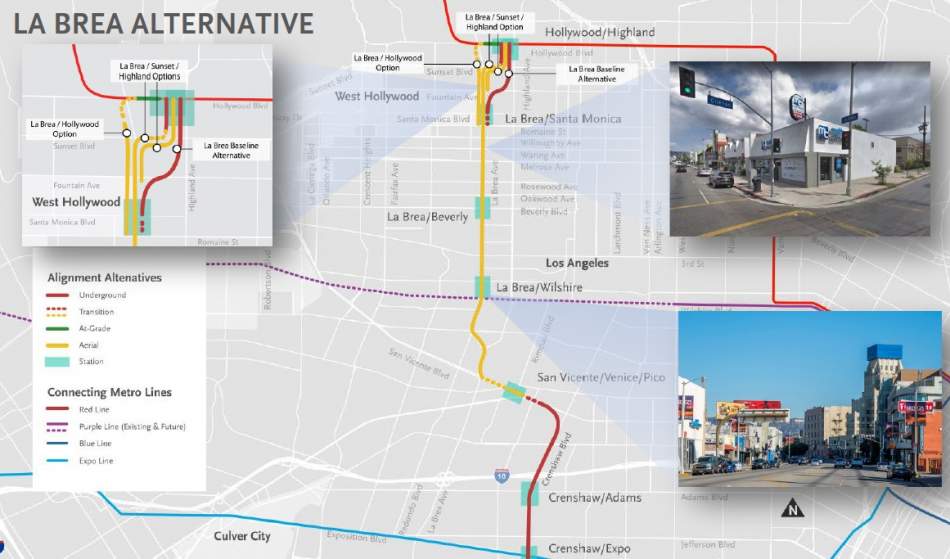
La Brea provides perhaps the most direct route toward Hollywood, albeit without hitting a significant number of regional destinations.
After trains daylight onto Venice Boulevard, the alignment would proceed briefly along San Vicente Boulevard before turning north to run on an aerial structure above La Brea Avenue. Stations would be planned at Wilshire Boulevard - to connect with the Purple Line - and Beverly Boulevard in the City of Los Angeles. West Hollywood would receive a single station at its eastern border at Santa Monica Boulevard.
North of Santa Monica Boulevard, the alignment could proceed in a variety of above- and below-grade options, all of which would terminate at Hollywood & Highland.
Vermont
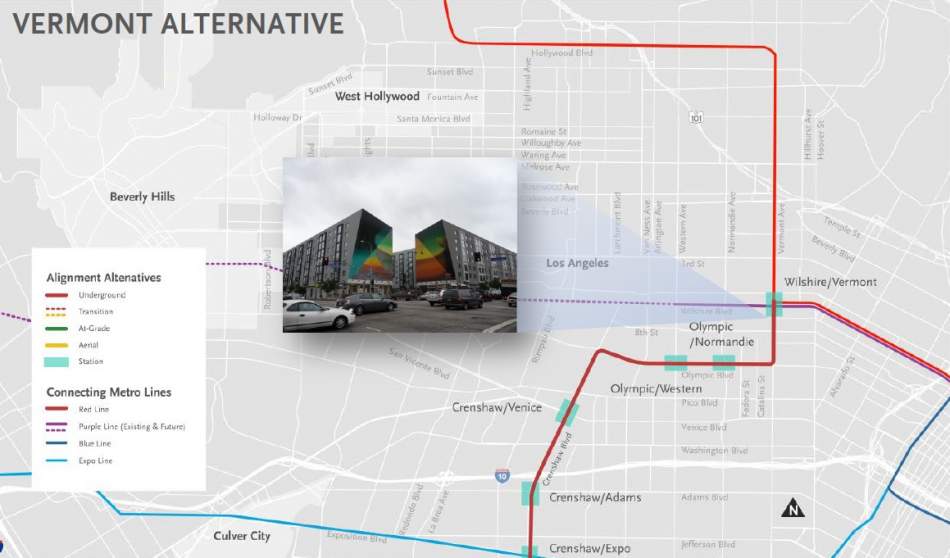
The final alternative - Vermont Avenue - imagines the Northern Crenshaw Line extension instead turning toward Koreatown.
The Vermont alternative calls for fully underground tracks running north on Crenshaw Boulevard before turning east at Olympic Boulevard, with stations to be located at Western and Normandie Avenues. The route then veers north at Vermont Avenue, towards a terminus that would connect - but not interline - with Red and Purple Line at Wilshire/Vermont Station.
It is unclear how this option would intersect with a future Vermont Avenue rail line, which Metro has long considered, but never made definitive plans to build.
How do they measure up?
Ridership projections for the five alternatives range from approximately 77,700 daily boardings to 90,800 daily boardings. It is expected that the northern extension would attract anywhere from 15,480 to 23,630 new transit trips.
The more circuitous Fairfax, La Cienega, and San Vicente alternatives offer a larger number of stations, albeit with longer trip times than the shorter La Brea and Vermont counterparts. San Vincente and La Cienega in particular feature substantial at-grade operations, where trains could be subject to impacts from vehicle traffic.
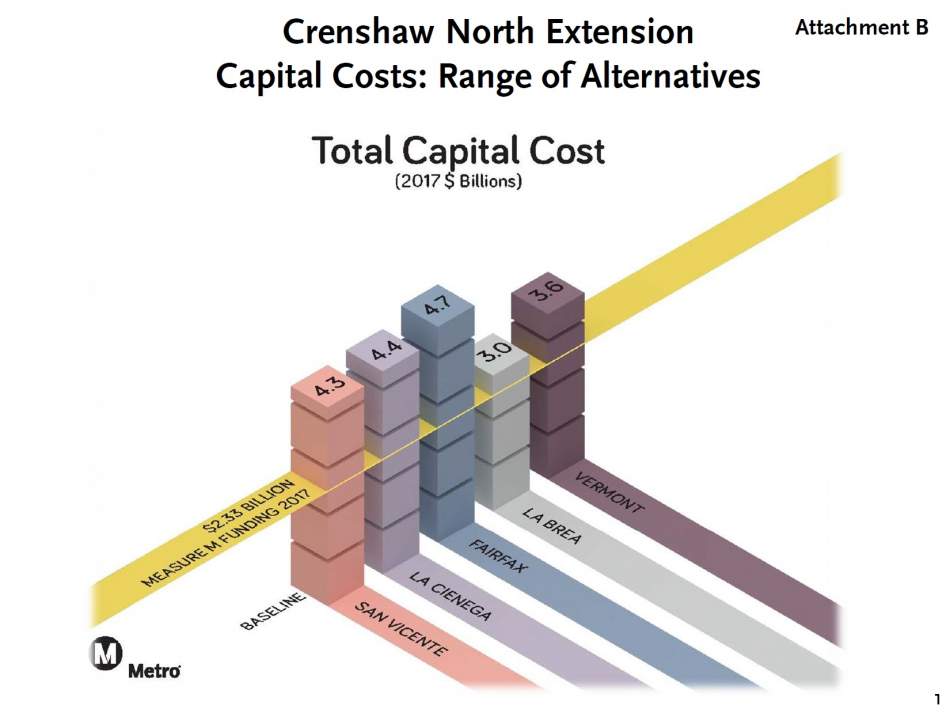
Fairfax Avenue - with an approximate cost of $4.7 billion - is estimated as the most expensive alternative to construct, with full grade separation between San Vicente Boulevard and Hollywood and Highland. Likewise, the longer distances required by the San Vicente and La Cienega options also push their price tags in excess of $4 billion. La Brea, which elects for aerial tracks in lieu of more costly subway construction, would cost approximately $3 billion. The shorter distance of the Vermont alternative also makes it a bargain - at least at face value - with a $3.6-billion price tag.
Vermont stands out as the most expensive alternative on a per-mile basis, with an estimated cost of $712 million. Fairfax comes in as a distant second, estimated at $575 million per mile due to its substantial grade separation. The La Cienega, San Vicente, and La Brea alignments provide similar levels of cost-effectiveness - with estimated per-mile budgets all in the range of $480 million.
- Crenshaw Line Archive (Urbanize LA)




